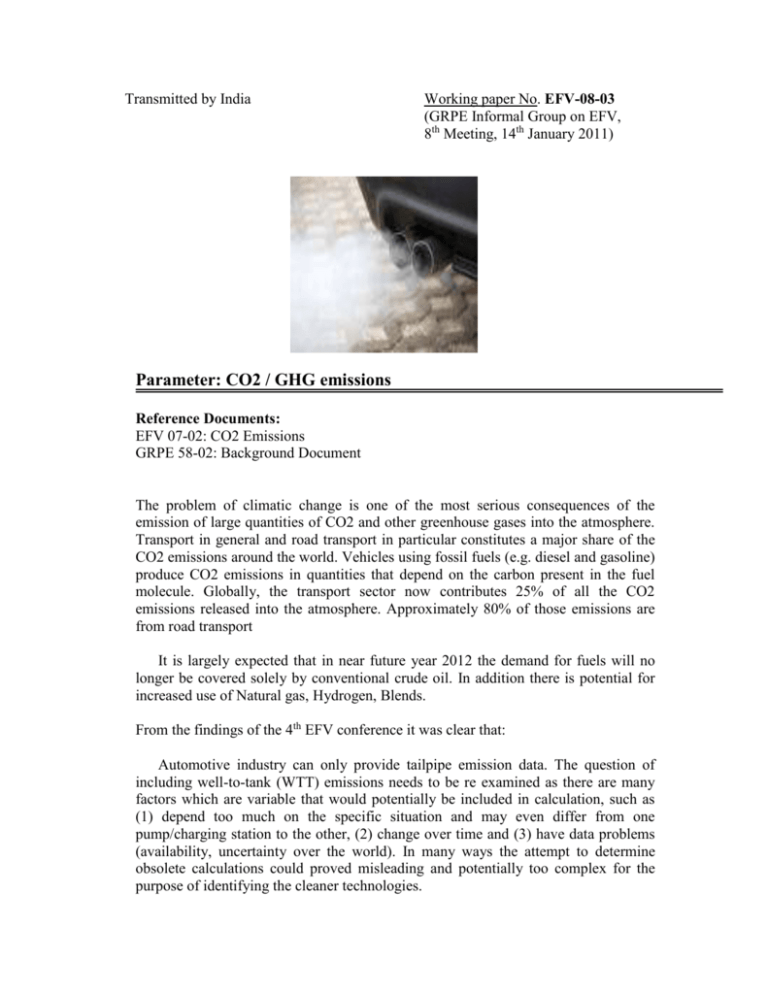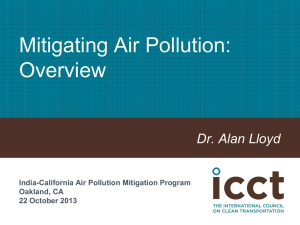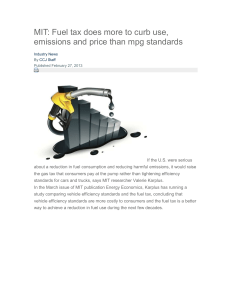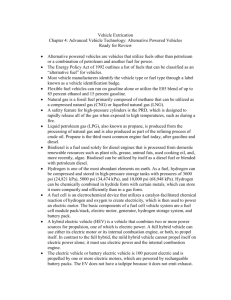3rd Approach: Fuel Consumption Ratings
advertisement

Transmitted by India Working paper No. EFV-08-03 (GRPE Informal Group on EFV, 8th Meeting, 14th January 2011) Parameter: CO2 / GHG emissions Reference Documents: EFV 07-02: CO2 Emissions GRPE 58-02: Background Document The problem of climatic change is one of the most serious consequences of the emission of large quantities of CO2 and other greenhouse gases into the atmosphere. Transport in general and road transport in particular constitutes a major share of the CO2 emissions around the world. Vehicles using fossil fuels (e.g. diesel and gasoline) produce CO2 emissions in quantities that depend on the carbon present in the fuel molecule. Globally, the transport sector now contributes 25% of all the CO2 emissions released into the atmosphere. Approximately 80% of those emissions are from road transport It is largely expected that in near future year 2012 the demand for fuels will no longer be covered solely by conventional crude oil. In addition there is potential for increased use of Natural gas, Hydrogen, Blends. From the findings of the 4th EFV conference it was clear that: Automotive industry can only provide tailpipe emission data. The question of including well-to-tank (WTT) emissions needs to be re examined as there are many factors which are variable that would potentially be included in calculation, such as (1) depend too much on the specific situation and may even differ from one pump/charging station to the other, (2) change over time and (3) have data problems (availability, uncertainty over the world). In many ways the attempt to determine obsolete calculations could proved misleading and potentially too complex for the purpose of identifying the cleaner technologies. Therefore for the first stage of implementation of EFV approach the Tank-towheel (TTW) GHG emission data to be only considered. The discussions about the role of vehicle as CO2 emitter strongly depend upon the generation of the fuel. For eg: the environmental performance of the fuel cell running on hydrogen produced by solar electrolysis is outstanding. Fuel cells using renewable such as biomass are also almost entirely clean. However both fuel generation techniques are far away from covering today’s or future energy demand of the transportation sector. Therefore, the new technologies that are fuel efficient and low polluting should be identified and implemented in use. For eg. Medium term fuel cells running on fossil fuels may become the most important alternative to IC Engine. The comparison between electric vehicle and I.C. engine vehicle may be partially accounting, if we consider TTW (Tank to Wheel) emissions. In countries like India, Germany, USA, substantial electrical energy is generated by fossil fuels, which have high carbon emissions. However, the generation of electricity and generation of fuels (Gasoline, Diesel, Hydrogen, CNG, and LPG) vary from the country to country. Here, the regional differentiations come in to the picture. The only way to remove this regional differentiation is to consider Tank-to-wheel emissions (TTW), instead of complete Well-to-wheel emissions (WTW), thereby making comparatively a common platform to compare all the vehicles. While finalizing the parameters and deciding the approach to evaluate the Environmentally Friendly Vehicle, it was discussed and deemed appropriate to replace the term CO2 emission with GHG emissions so as to concentrate on GHG emissions rather than focusing only on CO2 emissions. GHG include carbon di oxide, methane, nitrous oxide, ozone, HFCs (hydro fluorocarbons) and PFCs (per fluorocarbons). Hence proper attention is to be given to the GHG emissions ratings. Electricity Production from different sources in different countries in the world for 2007: Fossil Fuels in % * Hydro in % Nuclear in % Others in % India 72 16 2 10 Germany 62 3 24 11 USA 69 7 18 6 Japan 33 8 28 31 UK 71 1 20 8 Sweden 2 47 45 6 Source: CARMA data table by country, CARMA, 2008 *The fossil fuel fraction in the energy mix combines gas, oil, coal and lignite use. Additionally, the CO2 released during the production is very much less than the CO2 release during the use of vehicle. This is justified from the chart shown belw. The chart is the outcome of Mercedes LCA study by Well-to-Wheel Approach. The vehicle and fuel production only constitutes upto 20% as compared to 80% CO2 emissions during the vehicle in-use phase. Source: GRPE 58-02 Background document The LCA study by VW is also showing the similar outcome. Source: GRPE 58-02 Background document Still, some approaches are given below which accounts for Well-to-Wheel approach. Total 5 approaches are given which are as follows: 1. CO2 Emissions based Rating 2. Fuel Consumption Ratings (Regulation Based Ratings) 3. Fuel Consumption Ratings (Energy consumption) 4. Well – To – Wheel Energy Efficiency The Current European Test procedure should be followed for testing the vehicles along with the New European Driving Cycle (NEDC) or the World Harmonized Driving Cycle and the Test procedure for the evaluation of passenger vehicle under WLTP can lead to common methodology for the measurement of CO2 along with Regulated Pollutants. Total 4 approaches for the CO2 are explained below, which can be developed further after the discussions with the committee/group experts. 1st Approach: CO2 Emissions based Rating CO2 based ratings should be adopted instead of Fuel Consumption Ratings, as fuel consumption quoted in g/km is fuel neutral. The fuel consumption for liquid fuels is km/l while for gaseous fuels it is km/kg. Considering this the CO2 based ratings should be adopted. Additionally, CO2 is an index for both Fuel efficiency and GHG emissions. The base value for this approach has been taken as 80 g/km CO2 emission. This value has been chosen keeping in view the CO2 emissions from Hybrid vehicles. The rating of CO2 is for M1 category of vehicles irrespective of Reference Mass. The vehicle emitting 80g/km or lower will get 100 score. CO2 Emissions in g/km From <80 80 >100 >120 >140 >160 >180 >200 >220 >240 `>260 Up to and including 100 120 140 160 180 200 220 240 260 - Score 100 90 80 60 70 50 40 30 20 10 0 2nd Approach: Fuel Consumption Ratings (Regulation Based Ratings) Japan has proposed the future fuel consumption norms, which will be applicable from year 2015 in Japan. The fuel consumption values based on the vehicle mass are stated in the table. The same norms can be used as the criteria for determining the Environment friendliness of a vehicle in terms of fuel consumption. JAPAN CO2 Reduction / Fuel Efficiency Targets: Vehicle weight in Kg and Fuel Efficiency in km/l Gasoline Passenger Cars – Targets from 2010 703 – 82810161266827 1015 1265 1515 21.1 18.8 17.9 16 13 Diesel Passenger Cars – Target from 2005 ≤1015 101612661265 1515 18.9 16.2 13.2 LPG Passenger Cars – Targets for 2010 <702 703-827 828101612661015 1265 1515 15.9 14.1 13.5 12 9.6 < 702 15161765 10.5 17662015 8.9 20162265 7.8 22662500 6.4 15161765 11.9 17662015 10.8 20162265 9.8 22662500 8.7 15161765 7.9 17662015 6.7 20162265 5.9 22662500 4.8 10811195 18.7 21012270 8.7 11951310 17.2 ≥2271 13111420 15.8 14211530 14.6 Gasoline Passenger Cars – Targets from 2015 ≤600 22.5 15311650 13.2 601740 21.8 16511760 12.2 741855 21 17611870 11.1 856-970 20.8 18711990 10.2 9711080 20.5 19912100 9.4 7.4 Vehicle class PC Small Buses LCV 2004 Avg. value – km/l 13.6 8.3 13.5 2015 Avg. value – km/l 16.8 8.9 15.2 Change % 23.6 7.2 12.6 The approach put forward by the JAPAN will be more suitable as different ratings are suggested for the vehicles with different weight. This approach is also in-line with the future regulations. The vehicle following this norm will be marked with that fuel consumption value and some tax exemptions, incentives should be given for the manufacturing and purchasing of that vehicle. 3rd Approach: Fuel Consumption Ratings (Energy consumption) Under this approach, the fuel or electricity consumption is converted into the energy consumption, so that the Electric motor and IC engine vehicles can be brought down on a similar platform for comparison. Energy Gasoline obtained by burning one 34.8 MJ liter of Density Diesel LPG CNG 38.6 MJ 25.4 MJ 37-40 MJ/m3 0.751 Kg/l 0.8342 Kg/l 0.5 kg/l 0.128 kg/l @ 15 Deg C @ 15 Deg C @ 200 bar Here, the energy content of Diesel is maximum. So, diesel energy content has been considered as a base. Thus, to define the ratings in terms of energy consumption per km run. Based on the surveys and the analysis conducted over the vehicles to find out the best vehicle in terms of fuel consumption of 22.5 kmpl ( which is treated as best fuel consumption) is to be taken as a reference and other vehicle to be rated based on this reference FC. For Running 1 km of Gasoline/Diesel/CNG/LPG operated vehicle, energy required in MJ = 38.6 / (Fuel Consumption in km/lit) For Running 1 km of electric vehicle, Energy required = Electricity required for running the vehicle in kW-hr/km, which can further be converted to MJ by multiplication of 3.6 Rating 100 80 60 40 20 Fuel Consumption in Km/l Energy consumption in MJ/km FC ≥ 22.5 18.75 ≤ FC < 22.5 16 ≤ FC < 18.75 14 ≤ FC <16 FC < 14 From < 1.715 1.715 2.058 2.4 ≥ 2.74 To < 2.058 <2.4 <2.74 - For Example: A Gasoline vehicle with a Equivalent Inertia Mass of 1250 kg has a Fuel consumption of 14 km/l, and an Electric Vehicle with the consumption of 32 kW-hr / 100 km (115.2 MJ for 100 km). So the energy required to drive one km will be: For Gasoline vehicle = 2.48 MJ / km, will get the rating as 40. For Electric vehicle = 1.152 MJ / km, will get the rating as 100. The criteria for fuel consumption has been chalked based on the fuel consumption values. The fuel consumption of 22.5 kmpl ( which is treated as best fuel consumption) is taken as a base value. So the vehicle having fuel consumption > 22.5 will get 100 score. The vehicle will get 80 as a score, if the FC value will be between 22.5 and 22.5* 100/ (100-80) = 18.75 kmpl. The criteria for the energy consumption have been chalked out on the basis of energy content by fuel. The diesel has the highest value of energy content, which is taken as a base value. The energy consumption by the vehicle per km has been calculated as 38.6 / Fuel consumption limits. i.e. 38.6 /22.5 =1.715. This is how the criteria has been established. So, from the above example it is clear that the electric vehicle is consuming less amount of energy to drive the vehicle than Gasoline and diesel vehicle. Thus, each vehicle can be compared with reference to the energy required to run the vehicle for one km. 4th Approach: Well – To – Wheel Energy Efficiency Gasoline Cars The well-to-wheel energy efficiency of a normal gasoline-powered car can be found out by taking gasoline’s energy content, which is 34.8 MJ/l , into consideration. Secondly, if we know the efficiency of production of the gasoline and its transportation to the gasoline station, the WTW energy efficiency can be found out as: A = efficiency of production of gasoline and its transportation to the station, B = 100 – A = energy content of the crude oil lost to production and transportation So, C = 34.8 / A will give the energy in MJ of crude oil required to produce one liter of Gasoline at pump. For eg, a Gasoline powered car with the fuel economy of 20 kmpl, its efficiency will be 20 / C which will give the distance covered by vehicle in one MJ considering Well-toWheel energy. However this efficiency of production of the gasoline and its transportation to the gasoline station vary from nation to nation. Hybrid Cars All hybrid cars, except Plug in Hybrid cars, available today have no provision to charge their batteries except by using energy that is ultimately generated by their gasoline engines. This means that they may be considered, from a pollution and energy efficiency perspective, to be nothing more than somewhat more efficient gasoline cars. Thus a hybrid car with fuel economy of 20 kmpl, this is exactly the same as an ordinary gasoline car that gets 20 kmpl. The same methodology described in the above part should be used to calculate Well-toWheel energy efficiency of a Hybrid car. Diesel Cars Diesel engines works without spark plugs and has higher compression ratios and temperatures than Petrol Engines. This leads to Higher Efficiency of a Diesel car. The well-to-wheel energy efficiency of a normal Diesel-powered car can be found out by taking Diesel’s energy content, which is 38.6 MJ/l, into consideration. Secondly, if we know the efficiency of production of the diesel and its transportation to the fuelling station, the WTW energy efficiency can be found out as: A = efficiency of production of diesel and its transportation to the station, B = 100 – A = energy content of the diesel is lost to production and transportation So, C = 38.6 / A will give the energy in MJ of crude oil required to produce one liter of Gasoline at pump. Electric Cars: The most efficient way to produce electricity is with a “combined cycle” natural gas-fired electric generator. (A combined cycle generator combusts the gas in a high-efficiency gas turbine, and uses the waste heat of this turbine to make steam, which turns a second turbine – both turbines turning electric generators.) If, E1 is the efficiency of electric generators E2 is the efficiency of recovery of the natural gas/ coal/energy source E3 is the efficiency of the processing of the natural gas/ coal/energy source E4 is the efficiency of electric grid So the “well-to-electric-outlet” efficiency ‘A’ will be E1 x E2 x E3 x E4 B is the energy required to drive the vehicle for 1 km Then, Well-to-wheel energy efficiency of the vehicle will be B/A Here also the regional differentiation will play a vital role. The efficiencies of production, distribution, storage will vary from nation to nation. This approach is only given for information. It should not be adopted, because it is very difficult to find out the efficiencies of the different processes carried out during the extraction, production and transportation of crude oil. The petroleum infrastructure of the specific country could be different from the other. The availability and the authenticity of the data over this approach is also a major concern. However, one option here could be explored that the average CO2 emissions from the all models of a single manufacturer should be calculated and that value should be compared for the rating purpose. This is to give the consideration to manufacturer not only to produce the low weight, small capacity cars but also to look after the comfort, luxury segment. The most suitable approach for CO2 Emissions could be found out through the discussions with the experts. ***************








